unit 1 单元整体教案1
PEP小学英语四年级上册Unit1教案优秀7篇
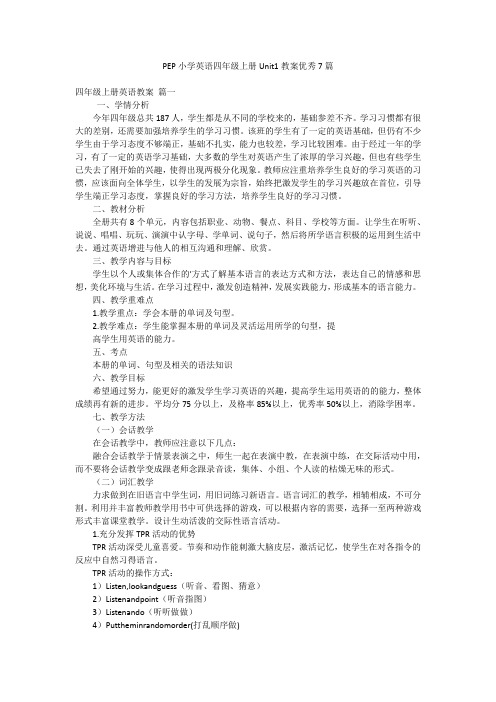
PEP小学英语四年级上册Unit1教案优秀7篇四年级上册英语教案篇一一、学情分析今年四年级总共187人,学生都是从不同的学校来的,基础参差不齐。
学习习惯都有很大的差别,还需要加强培养学生的学习习惯。
该班的学生有了一定的英语基础,但仍有不少学生由于学习态度不够端正,基础不扎实,能力也较差,学习比较困难。
由于经过一年的学习,有了一定的英语学习基础,大多数的学生对英语产生了浓厚的学习兴趣,但也有些学生已失去了刚开始的兴趣,使得出现两极分化现象。
教师应注重培养学生良好的学习英语的习惯,应该面向全体学生,以学生的发展为宗旨,始终把激发学生的学习兴趣放在首位,引导学生端正学习态度,掌握良好的学习方法,培养学生良好的学习习惯。
二、教材分析全册共有8个单元,内容包括职业、动物、餐点、科目、学校等方面。
让学生在听听、说说、唱唱、玩玩、演演中认字母、学单词、说句子,然后将所学语言积极的运用到生活中去。
通过英语增进与他人的相互沟通和理解、欣赏。
三、教学内容与目标学生以个人或集体合作的'方式了解基本语言的表达方式和方法,表达自己的情感和思想,美化环境与生活。
在学习过程中,激发创造精神,发展实践能力,形成基本的语言能力。
四、教学重难点1.教学重点:学会本册的单词及句型。
2.教学难点:学生能掌握本册的单词及灵活运用所学的句型,提高学生用英语的能力。
五、考点本册的单词、句型及相关的语法知识六、教学目标希望通过努力,能更好的激发学生学习英语的兴趣,提高学生运用英语的的能力,整体成绩再有新的进步。
平均分75分以上,及格率85%以上,优秀率50%以上,消除学困率。
七、教学方法(一)会话教学在会话教学中,教师应注意以下几点:融合会话教学于情景表演之中,师生一起在表演中教,在表演中练,在交际活动中用,而不要将会话教学变成跟老师念跟录音读,集体、小组、个人读的枯燥无味的形式。
(二)词汇教学力求做到在旧语言中学生词,用旧词练习新语言。
人教PEP三年级上册英语Unit1 整单元教案

人教PEP三年级上册英语教案Unit 1 Hello!Teaching aims:1.listen, speak” Hello./hi. Goodbye./bye-bye. I'm ....”2.pass the creaton greetings, introduce yourself and say goodbye, etc scenarios, let the students learn greetings, introduce yourself and farewell colloquialisms 3.cultivate students willing to openings, dare to speak English habits, inspiring students want to learn, and loving wishes.Teaching key point: Greetings, introduce yourself and say farewell greetings session learning, so that students in differen t situations to listen, speak “Hello./hi. Goodbye./bye-bye. I'm ....”Teaching difficult:pronunciation of “I’m”Teaching aid:mask,tape第一课时Teaching content:Part A Let’s talk,Let’s playProcess of teaching :一、Warm-up1.Teacher show the picture about “Cartoon”,students look at the picture and listen dialoge.2.Tell students “cartoon” pronunciation is made by the word of English words cartoon directly translation of pronunciation.In reality, we still have many similarities, sometimes we even directly used English words to represent something as a CD, VCD, DVD, etc二、Presentation1.Broadcast song “Hello”.2.Teacher extend greetings to students:”Hello, everyone.”3.Teacher introduce self :”Hello!I’m Miss yang/Hi!I’m Miss yang.”4.Teacher show the mask and introdu ce:”Hello!I’m sary.”5.Students introduce with mask:”Hello!I’mMike……6.Broadcast the tape and students listen “Let’s talk”.三、Practice1.Let’s playStudents play game “One is drumming while the others pass round a spray of blossom -- a drinking-game (whoever has the blossom when the drum stops must drink a cup of wine).2.Produce the picture ,Let students say what to say in the picture.1)Morning,two children meet at the school doorway,what they say?2)Class begin,teacher brings a new schoolmate into classroom,freshmanintroduce self.3)Get out of class,there are several classmate and freshman meet ,how theysay?4)School is over,classmate say what each other.3.Four a group practice to introduce self.四、AssessmentTeacher and students do students’exercise-book Unit 1 Part 1.五、Add-activitiesMake the mask about somebody in book.Feedback:第二课时Teaching content:Part A Let’s learn, Let’s doProcess of teaching:一、Warm-up1.Sing a song:”Hello”2.Students take Sarah, Wu Yifan counterpart masks and introduce:”Hello!sarah!......”3.Play a game:Listen sounds,find pals.二、Presentation1.Teach words and use sentences:”Show me your…….”Teacger show a bag and students guess :”What’s in the bag?”Students guess and teaacher present the things,teacher teach word.Teacher says order:”Show me your …….”2.teacher read and students follow teacher。
2024年冀教版英语三年级上册教案带反思第一单元整体设计思路

Unit 1 Hello!
单元整体设计思路:
明确学习目标与内容:
引导学生掌握基本的问候用语,如“Hello!”等,学会如何询问和告知姓名。
学习和掌握与问候相关的歌曲,通过歌曲加深对问候内容的理解和记忆。
创设生动有趣的教学情境:
利用插图和实物,创设与问候相关的情境,如见面打招呼、询问新朋友姓名等。
通过角色扮演、对话练习等方式,让学生在情境中实践问候和询问姓名的用语。
注重基础知识的讲解与练习:
详细讲解问候和询问姓名的基本用法和表达方式,确保学生能够准确掌握。
通过课堂练习和小组活动,让学生反复练习,巩固所学知识。
融合歌曲教学,提升学习兴趣:
引导学生学习第一单元中的歌曲,通过唱歌的方式加深对问候内容的理解和记忆。
鼓励学生边唱边做动作,提高学习的趣味性和互动性。
培养语言运用能力和交际能力:
通过模拟真实场景的对话练习,让学生在实际情境中运用所学知识,提高语言表达能力。
引导学生与同伴进行互动交流,培养他们的交际能力和合作精神。
注重教学评价与反馈:
通过观察学生的学习表现和课堂参与度,及时给予评价和反馈。
鼓励学生积极参与课堂讨论和实践活动,培养他们的学习兴趣和自信心。
整个教学思路涵盖了第一单元的主要学习内容,充分考虑了学生的认知特点和兴趣爱好,旨在创造一个轻松愉快的学习氛围,让学生在玩中学、学中玩。
人教版PEP小学英语五年级下册Unit 1 教案(一)

(1)教师请同学说说他的时间表,教师板书,并与Pedro的作比较。如:
S1 Pedro
6:30 a.m. get up 7:00 a.m. do morning exercises
7:00 a.m. eat breakfast 8:00 a.m. eat breakfast
2.能利用所学句型询问和表达周末做了什么事。如:—What do you do on the weekend?—I usually/often…on the weekend.
2.学习Let’s talk。
(1)播放Let’s talk录音。边播放边请同学们思考问题:When does Pedro finish class in the morning?When does Pedro go back to school after lunch?When does Pedro usually eat dinner in Spain?
T:When do you get up? S1:I get up at…
T:When do you eat breakfast? S2:I eat breakfast at…
2.Tell your partner about your tim Nhomakorabeatable.
通过师生间相互问候融洽课堂气氛,同时交谈内容也引出了新课。
Part B
教学导航
教学内容
第一课时Let’s learn Do a survey第二课时Let’s try Let’s talk
第三课时Read and write Let’s check
教学目标
【知识目标】1.能听、说、读、写clean my room, go for a walk等单词短语,并能熟练的掌握运用。
高一英语必修一unit1教案(优秀3篇)
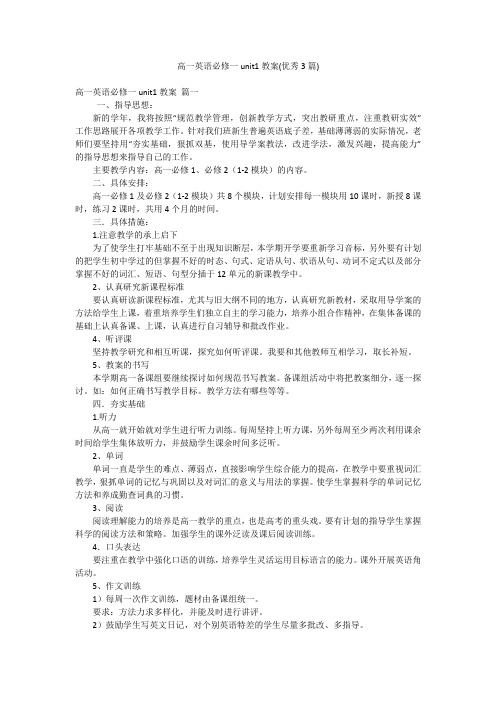
高一英语必修一unit1教案(优秀3篇)高一英语必修一unit1教案篇一一、指导思想:新的学年,我将按照“规范教学管理,创新教学方式,突出教研重点,注重教研实效”工作思路展开各项教学工作。
针对我们班新生普遍英语底子差,基础薄薄弱的实际情况,老师们要坚持用“夯实基础,狠抓双基,使用导学案教法,改进学法,激发兴趣,提高能力”的指导思想来指导自己的工作。
主要教学内容:高一必修1、必修2(1-2模块)的内容。
二、具体安排:高一必修1及必修2(1-2模块)共8个模块,计划安排每一模块用10课时,新授8课时,练习2课时,共用4个月的时间。
三.具体措施:1.注意教学的承上启下为了使学生打牢基础不至于出现知识断层,本学期开学要重新学习音标,另外要有计划的把学生初中学过的但掌握不好的时态、句式、定语从句、状语从句、动词不定式以及部分掌握不好的词汇、短语、句型分插于12单元的新课教学中。
2、认真研究新课程标准要认真研读新课程标准,尤其与旧大纲不同的地方,认真研究新教材,采取用导学案的方法给学生上课,着重培养学生们独立自主的学习能力,培养小组合作精神,在集体备课的基础上认真备课、上课,认真进行自习辅导和批改作业。
4、听评课坚持教学研究和相互听课,探究如何听评课。
我要和其他教师互相学习,取长补短。
5、教案的书写本学期高一备课组要继续探讨如何规范书写教案。
备课组活动中将把教案细分,逐一探讨。
如:如何正确书写教学目标。
教学方法有哪些等等。
四.夯实基础1.听力从高一就开始就对学生进行听力训练。
每周坚持上听力课,另外每周至少两次利用课余时间给学生集体放听力,并鼓励学生课余时间多泛听。
2、单词单词一直是学生的难点、薄弱点,直接影响学生综合能力的提高,在教学中要重视词汇教学,狠抓单词的记忆与巩固以及对词汇的意义与用法的掌握。
使学生掌握科学的单词记忆方法和养成勤查词典的习惯。
3、阅读阅读理解能力的培养是高一教学的重点,也是高考的重头戏。
高一英语必修一unit1教案
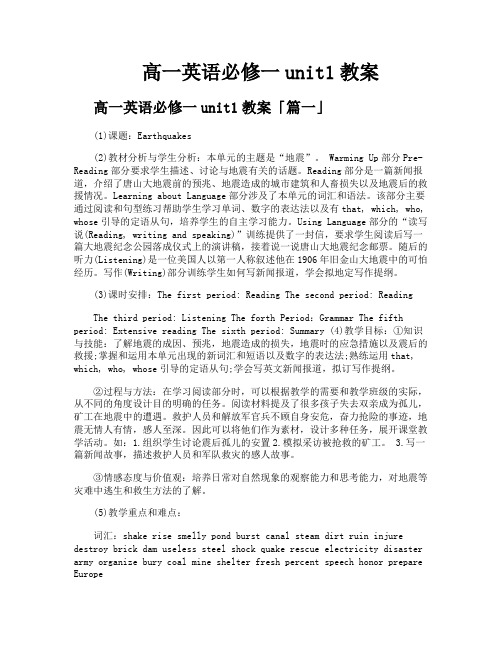
高一英语必修一unit1教案高一英语必修一unit1教案「篇一」(1)课题:Earthquakes(2)教材分析与学生分析:本单元的主题是“地震”。
Warming Up部分Pre-Reading部分要求学生描述、讨论与地震有关的话题。
Reading部分是一篇新闻报道,介绍了唐山大地震前的预兆、地震造成的城市建筑和人畜损失以及地震后的救援情况。
Learning about Language部分涉及了本单元的词汇和语法。
该部分主要通过阅读和句型练习帮助学生学习单词、数字的表达法以及有that, which, who, whose引导的定语从句,培养学生的自主学习能力。
Using Language部分的“读写说(Reading, writing and speaking)”训练提供了一封信,要求学生阅读后写一篇大地震纪念公园落成仪式上的演讲稿,接着说一说唐山大地震纪念邮票。
随后的听力(Listening)是一位美国人以第一人称叙述他在1906年旧金山大地震中的可怕经历。
写作(Writing)部分训练学生如何写新闻报道,学会拟地定写作提纲。
(3)课时安排:The first period: Reading The second period: ReadingThe third period: Listening The forth Period:Grammar The fifth period: Extensive reading The sixth period: Summary (4)教学目标:①知识与技能:了解地震的成因、预兆,地震造成的损失,地震时的应急措施以及震后的救援;掌握和运用本单元出现的新词汇和短语以及数字的表达法;熟练运用that, which, who, whose引导的定语从句;学会写英文新闻报道,拟订写作提纲。
②过程与方法:在学习阅读部分时,可以根据教学的需要和教学班级的实际,从不同的角度设计目的明确的任务。
统编小学英语四年级上册第一单元整体教学设计

统编小学英语四年级上册第一单元整体教学设计教学目标- 了解并掌握第一单元的词汇和句型- 能够运用所学知识进行简单的交流- 培养学生的听、说、读、写能力教学内容- 单词:apple, banana, cat, dog, egg, fish- 句型:What's this? It's a/an [noun]. / Is it a/an [noun]? Yes, it is. / No, it isn't.教学步骤1. 导入:通过展示图片或实物引入所学单词,激发学生的研究兴趣。
2. 听力训练:播放录音,让学生听并模仿录音中的单词和句型。
逐步提高难度,让学生能够听懂并回答简单问题。
3. 口语练:设计各种情境对话,让学生运用所学句型进行练,如问答练、角色扮演等。
4. 阅读训练:教师朗读相关文章,让学生跟读并理解文章内容,培养阅读能力。
5. 写作训练:要求学生根据所学单词和句型,描述或写出相关事物,培养写作能力。
6. 温故知新:复本单元所学内容,进行小结和课堂测验,巩固学生的研究成果。
教学资源- 图片或实物:苹果、香蕉、猫、狗、鸡蛋、鱼等- 录音机或多媒体设备- 练册和笔教学评估- 学生参与度:观察学生的积极性和参与程度- 听力理解:听录音并回答问题- 口语表达:参与对话练,准确运用句型- 阅读理解:朗读文章并回答问题- 写作能力:描述或写出相关事物以上是统编小学英语四年级上册第一单元整体教学设计。
实施教学过程中,可以根据实际情况适当调整和完善教学内容和步骤,以达到更好的教学效果。
unit 1 全单元教案( How can we become good learners)

Unit1Howcanwebecomegoodlearners教案【单元教学内容分析】本单元的话题习英语。
这个话题既有趣又实用,既能锻炼我们的语言能力,又能使我们学到一些实用的方法,对自身的学习大有帮助。
1.如何向别人请教学习方法呢?又如何回答呢?2.学会评价各种学习方法的优劣3.找出自己在英语学习中的困难4.确定自己的学习方法(Decideyoursuitablelearningways)【学习目标】认知目标:1.Talkabouthowtostudy.学会讨论各种学习方法和策略。
2.Findoutyoursuitablelearningmethods.找出适合自己的学习方法。
情感目标:通过对学习方法的学习,培养学生用正确而科学的方法做事的能力,明白“一份耕耘,一份收获”。
技能目标:(1)熟练掌握下列词汇pronunciationdiscoverrepeatnotepronounceincreasespeedpartnercreateactiveconnectreviewknowle dgewiselybornattention(2)熟练掌握下列短语:workwithfriendsasktheteacherforhelp readaloudlookuppracticepronunciationconnect…with…payattentionto(3)掌握下列句型:HowdoyoustudyEnglish?Ilearnbyworkingwithagroup.DoyoulearnEnglishbyreadingaloud?Yes,Ido.Ithelpsmypronunciation.HowcanIreadfaster?Youcanreadfasterbyreadingwordgroups.HowcanIimprovemypronunciation?Onewayisbylisteningtotapes. Butwhetherorcandothiswelldependsonyourlearninghabits.【重点、难点】1.学会运用how来询问做事方式2.学会运用by+结构表达做事方式。
Unit1单元整体教学设计(刘合良)-高中英语新教材必修第三册大单元整体教学设计+拼图式阅读(视频+

Unit1单元整体教学设计(刘合良)-高中英语新教材必修第三册大单元整体教学设计+拼图式阅读(视频+课件+教案)一、教学目标1.知识与技能:(1)学生能够掌握Unit 1的单词、词组及相关语法知识;(2)能够听、说、读、写、翻译单元中的重点句型及重要词汇;(3)能够运用所学知识用英语进行相应的交际活动。
2.过程与方法:(1)培养学生自主学习的习惯,提高学习能力;(2)通过听说读写综合训练,提高学生的英语表达能力;(3)培养学生独立思考的能力,激发学生的学习兴趣。
3.情感、态度与价值观:(1)通过让学生学习和体验文化差异,增强跨文化交流意识;(2)培养学生尊重不同文化、不同国家的认识,增强学生的国际视野。
二、教学内容Unit 1 Cultural relics词汇:antique, archaeological, collection, gallery, exhibit, statue, sculpture, artifact, treasure, masterpiece, restoration, authentic语法:定语从句的使用三、教学重难点1.重点:(1)学习Unit 1的单词、词组及相关语法知识;(2)掌握重点句型及重要词汇。
2.难点:(1)定语从句的使用;(2)培养学生自主学习的习惯,提高学习能力。
四、教学方法1.听力训练法:通过听力材料的训练,提高学生听力水平;2.阅读训练法:通过让学生阅读文章,提高学生阅读能力;3.口语训练法:通过让学生进行口语练习,提高学生口语表达的能力;4.写作训练法:通过让学生进行写作练习,提高学生的写作水平。
五、教学过程设计(以第一堂课为例)Step 1. Warm-up and lead-in1. Greet the students and ask them some general questions, such as “Have you ever visited a museum or an exhibition before? What did you see there?”2. Show the students some pictures of differentcultural relics from around the world and ask them to guess where they come from.3. Introduce the theme of the unit and ask the students what they know about cultural relics.Step 2. Presentation1. Present the new words and phrases using pictures, explanations and examples.2. Explain the grammar of defining relative clauses and provide some examples.Step 3. Practice1. Listen to a passage about cultural relics and ask the students to answer some questions about it.2. Read a passage about Egyptian culture and ask the students to identify the defining relative clauses in it.3. Ask the students to work in pairs to write some sentences about cultural relics using defining relative clauses.Step 4. Production1. Ask the students to work in groups to research and introduce a cultural relic from their own country.2. Encourage the students to use defining relative clauses in their descriptions.Step 5. Consolidation1. Summarize the main points of the lesson andreinforce the new words and phrases.2. Assign homework and preview the next lesson.六、教学资源准备1.多媒体教学设备;2.课件和教案。
四年级上册英语第一单元教案

四年级上册英语第一单元教案四年级英语上册《unit 1 my classroom》优质教案篇一一、教学目标1、能听懂、会说句子“let me/let's…”并做出正确的回应。
2、能够了解let引导的祈使句。
3、能够利用学过的动词短语创编let引导的祈使句。
4、培养学生讲究卫生的好习惯和珍惜他人劳动成果的意识。
二、教学重难点1、教学重点:能够听懂、会说let引导的祈使句并做出正确回应。
2、教学难点:能识别句型“is this the…?和is that the…”的不同用法并在真实情景中正确使用。
三、课前准备人物头饰,教学光盘,教学挂图。
四、教学过程step 1:warm up1、教师随机指着教室里的物体,学生用英语说出来,复习所学过的单词。
2、教师播放let's do部分的录音,让学生跟着录音练习课本第5页let's do部分的句子。
学生说说自己知道的祈使句或动词短语,老师鼓励学生上台带领其他学生边说边做动作。
step 2:presentation1、教师做擦黑板的动作,让学生发出相应的指令:clean the blackboard.从而引出单词clean,并教读,加深理解单词clean的意思。
然后教师说出需要打扫的地方,请学生用英语说出带有clean的动词短语,如:clean the windows;clean the desks(由clean the desks引出the teacher's desk.);clean the classroom;clean the doors…。
2、教师边擦窗户边说:“let me clean the windows.”并向学生解释“let me…”的含义以及用法。
找几名学生说出更多“let me…”的句子,边说边做,巩固句型“let me…”。
3、教师请几名学生上台和教师一起擦窗户,边擦窗户边说let's clean the windows!教师教读该句子,并引导学生弄清“let me…”和“let's…”的区别。
人教PEP英语四年级下册Unit 1上课教案(教学设计)

Unit 1 My school一、单元整体分析本单元是人教版英语四年级下册的第一单元,单元话题是“My school.”本单元重点学习学校、校舍;场馆的名称及相应的位置。
共三个版块:A 部分,B部分和C 部分。
A、B部分呈现新知识点,C部分是以讲故事形式巩固或延展知识面。
共分六课时来学习。
本单元A,B部分的Let’s learn 主要学习学校功能教室的名称。
Let’s talk. 以对话的方式引出重点句型。
read and write 部分呈现了本单元的四会单词及句型,从中学会了正确的书写格式。
Let’s spell 部分,要求学生通过听音、跟读,理解字母组合“er”的正确发音。
此外Look,ask and answer,Let’s do,Let’s play,Let’s sing,Let’s check和C部分的story time 则是通过多种多样的活动,与School 串联起来,让学生们在轻松愉快的情景中习得语言,运用语言。
在课堂教学中,首先要整体把握本单元教学内容、教学重点和教学难点,了解学生学情。
然后围绕本单元主题“My school”展开教学设计。
本单元的教学内容和学生相关,在组织语言教学时要注意设计生活化,充分利用教材已经设定的情境开展活动,帮助学生在合作学习中和任务型学习中正确表达所学句型。
鼓励学生自编歌谣巩固所学知识。
本单元所需要掌握的询问功能室的位置的句型“Where’s the …? It’s on the ….”在前面的教材中没有集中涉及,但是对于疑问代词“Where”同学们并不陌生。
询问某人来自哪里的句型“Where are you from?”在三年级下册教材中已经学过。
这个句型的表达对本单元的教学有一定的帮助。
二、单元教学目标1. 知识目标(1)能听、说、读三会单词teachers’ office;library;playground;computer room;art room;music room ;first floor;second floor。
人教PEP五年级上册【单元整体教学设计】Unit 1 My day PC Story time 教案

人教PEP五年级上册Unit 1 My day
单元整体设计
新课标第二部分分课时教学设计
【第7 课时】
一,语篇研读(附图)
本节课是故事篇,本课时的主题意义是通过Zoom和Zip在一起谈论Zip忙碌日常活动等,掌握如何讲述一些日常活动。
从而激发学生在真实的语言情境中来运用所学词汇和句型等。
让学生感知本节课句型的语义及语用情景。
能根据课文判断句子正误,回答相应的问题,并能情景表演故事等,养成合理安排作息时间的好习惯。
二,教学过程
核心素养教学目标
(一)学习能力目标:
1.能熟读课文完成课后相应练习并能运用所学短语和句型描述自己的日常活动
2.能在音频和图片语境的帮助下,学习听力题型和听力技巧。
3.有意识地运用所学字、词、句,培养“能听会说英语”的能力
(二)语言知识目标:
1.能在图片和文本语境的帮助下,熟练运用本单元的核心单词。
(鼎尖教案)新PEP小学英语四年级上册第一单元-单元整体教案
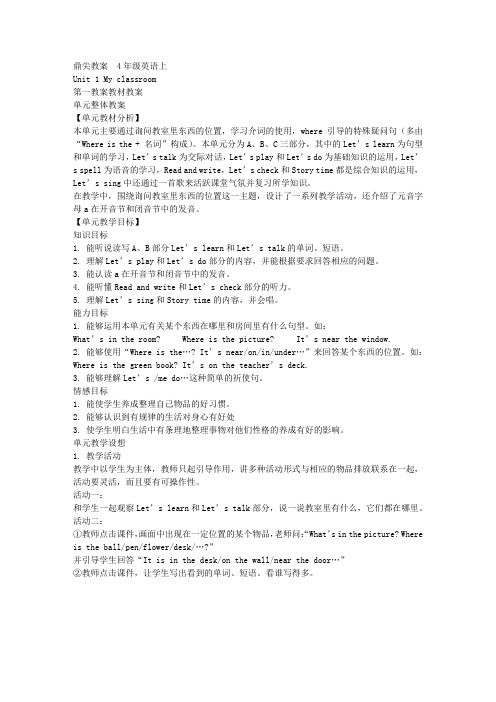
鼎尖教案 4年级英语上Unit 1 My classroom第一教案教材教案单元整体教案【单元教材分析】本单元主要通过询问教室里东西的位置,学习介词的使用,where引导的特殊疑问句(多由“Where is the + 名词”构成)。
本单元分为A、B、C三部分,其中的Let’s learn为句型和单词的学习,Let’s talk为交际对话,Let’s play和Let’s do为基础知识的运用,Let’s spell为语音的学习,Read and write,Let’s check和Story time都是综合知识的运用,Let’s sing中还通过一首歌来活跃课堂气氛并复习所学知识。
在教学中,围绕询问教室里东西的位置这一主题,设计了一系列教学活动,还介绍了元音字母a在开音节和闭音节中的发音。
【单元教学目标】知识目标1. 能听说读写A、B部分Let’s learn和Let’s talk的单词、短语。
2. 理解Let’s play和Let’s do部分的内容,并能根据要求回答相应的问题。
3. 能认读a在开音节和闭音节中的发音。
4. 能听懂Read and write和Let’s check部分的听力。
5. 理解Let’s sing和Story time的内容,并会唱。
能力目标1. 能够运用本单元有关某个东西在哪里和房间里有什么句型。
如:What’s in the room? Where is the picture? It’s near the window.2. 能够使用“Where is the…? It’s near/on/in/under…”来回答某个东西的位置。
如:Where is the green book? It’s on the teacher’s deck.3. 能够理解Let’s /me do…这种简单的祈使句。
情感目标1. 能使学生养成整理自己物品的好习惯。
2. 能够认识到有规律的生活对身心有好处3. 使学生明白生活中有条理地整理事物对他们性格的养成有好的影响。
U1 Letters in our life Letters in our life 教案
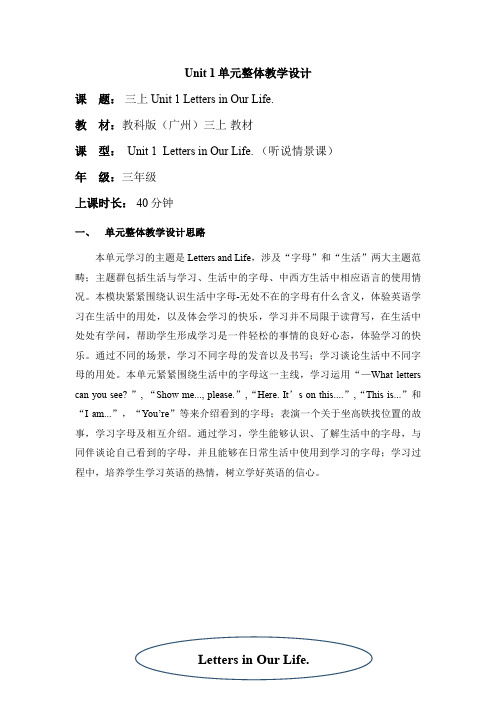
Unit 1单元整体教学设计课题:三上Unit 1 Letters in Our Life.教材:教科版(广州)三上教材课型: Unit 1 Letters in Our Life. (听说情景课)年级:三年级上课时长:40分钟一、单元整体教学设计思路本单元学习的主题是Letters and Life,涉及“字母”和“生活”两大主题范畴;主题群包括生活与学习、生活中的字母、中西方生活中相应语言的使用情况。
本模块紧紧围绕认识生活中字母-无处不在的字母有什么含义,体验英语学习在生活中的用处,以及体会学习的快乐,学习并不局限于读背写,在生活中处处有学问,帮助学生形成学习是一件轻松的事情的良好心态,体验学习的快乐。
通过不同的场景,学习不同字母的发音以及书写;学习谈论生活中不同字母的用处。
本单元紧紧围绕生活中的字母这一主线,学习运用“—What letters can you see? ”, “Show me..., please.”,“Here. It’s on this....”,“This is...”和“I am...”,“You’re”等来介绍看到的字母;表演一个关于坐高铁找位置的故事,学习字母及相互介绍。
通过学习,学生能够认识、了解生活中的字母,与同伴谈论自己看到的字母,并且能够在日常生活中使用到学习的字母;学习过程中,培养学生学习英语的热情,树立学好英语的信心。
Letters in Our Life.二、语篇研读(附图)What:本节课选自教科版(广州)三年级上册Unit 1 Letters in Our Life. 本部分学习的核心语言是学习用对话并使用句型“You’re... ”, “I’m... ”, “Nice to meet you”, “Thank you”,“this is ...”进行对话。
课文通过听力训练,加强学生对于“1A, 1B, yes, you’re, I’m= I am, this, is”等的认知,再通过情景对话“You’re... ”, “I’m... ”, “Nice to meet you”, “Thank you”,“this is ...”增强学生的实际运用能力。
Unit1What'sthematter单元整体教案

2.引导与启发:在讨论过程中,我将作为一个引导者,帮助学生发现问题、分析问题并解决问题。我会提出一些开放性的问题来启发他们的思考。
3.成果分享:每个小组将选择一名代表来分享他们的讨论成果。这些成果将被记录在黑板上或投影仪上,以便全班都能看到。
Unit 1 What's the matter单元整体教案
一、教学内容
《Unit 1 What's the matter》单元整体教案,针对五年级英语课程,教学内容主要包括:
1.掌握与身体不适相关的词汇,如:headache, stomachache, toothache, fever, cough等;
(三)实践活动(用时10分钟)
1.分组讨论:学生们将分成若干小组,每组讨论一个与身体不适相关的实际问题。
2.角色扮演:为了加深理解,我们将进行角色扮演活动。这个活动将演示如何在实际情境中使用所学词汇和句型。
3.成果展示:每个小组将向全班展示他们的讨论成果和角色扮演的过程。
(四)学生小组讨论(用时10分钟)
(3)给出建议的表述:学生可能难以运用正确的语法结构给出建议,如:should, shouldn&(1)针对词汇教学难点,教师可以设计单词卡片、拼写游戏、词汇接龙等活动,帮助学生记忆。
(2)针对句型难点,教师可以设置不同场景,让学生进行角色扮演,增加实际运用机会。
(3)针对给出建议的难点,教师可以提供一些模板,引导学生进行模仿和替换练习,逐步提高学生运用语法结构的能力。
二、核心素养目标
《Unit 1 What's the matter》单元核心素养目标:
三年级上册第一单元单元整体教学设计教案

三年级的孩子接触英语时间不长,大多数孩子学习积极性比较高,所以孩子很容易被吸引,大部分学生会认真听讲,但持续时间不长,还有个别学生不太容易集中注意力,上课容易跑神儿,所以我们要根据学生年龄特点,课堂上一定要抓住学生的注意力,并且要有活动刺激学生持续的注意力,激发兴趣,保证学习效果。
三、学习目标课Biblioteka 教学设计基本信息姓名
王双路
学校
夹津口镇中心小学
联系电话
13783561253
学段
三
课时名称
第一课时
课时教学设计
课题
Unit1HelloALet’s talk Let’s play
课型
词汇课
一、教学内容分析
本课是第一单元的第一课时,本部分对话重现了A部分的核心句型,通过MissWhite ,Wu Yifan 和Sarah在教室见面打招呼互致问候的情景,提供学生要学习的核心句型Hello!/Hi! I’m ……。通过学习核心句型,要让学生能够理解对话大意,能用正确的语音语调朗读对话,能够在语境中运用Hello!和Hi!与别人打招呼,并能够运用句型I’m ……介绍自己。
本单元共分A、B、C三部分。A部分共三页,分三课时。第一课时为情景对话和练习部分。Miss White(怀特老师)在同这个学期的新同学们打招呼并介绍自己,引出本课时用于介绍自己的句式:I’m... 以及打招呼用语:Hello! Hi! Let’s play(玩一玩)部分提供了一个课堂游戏活动,两个学生头戴教材主人公的头饰在做自我介绍。希望学生可以通过这样的角色饰演达到操练重点句式的目的。第二课时为重点词汇和重点句型呈现,Zoom和Zip带领大家认识文具类词汇:ruler, eraser, pencil, crayon,以及表示自己拥有某物的句式:I have a/an... 并通过韵句:I have a ruler. Me, too. 来进一步巩固重点单词和句型。第三课时为字母学习,通过字母歌,初步接触英语的二十六个字母,并在找一找活动中熟悉二十六个字母的字形。
小学三年级英语上册Unit1教案3篇人教版三年级上册英语unit1教案

小学三年级英语上册Unit1教案3篇人教版三年级上册英语unit1教案小学三年级英语上册Unit 1 教案1第一课时一、教学内容与分析1、Let’s talk本部分通过情景会话,让学生学习如何用What’s your name? 询问对方的姓名以及另一种表达道理别的说法:See you.2、Let’s play本部分从实际生活入手,通过玩游戏来进一步巩固Let’s talk中的会话,同时学习欢迎语e!二、课前准备教师应准备自己的名字卡及本课主要人物的头饰;要示学生准备一个面具,并制作一个写有本人姓名的头饰。
三、教学步骤1、热身/复习(Warm-up/ Revision)(1)、唱“Hello”歌(2)、师生互相问候(3)、学生将名卡戴在胸前,分别起立做自我介绍2、新课展示(Presentation)(1)、老师指自己的名卡说Hello! I’m Miss / Mr。
然后用My name’s。
再重复两遍自己的名字。
接着对一名学生发问What’s your name? (用清晰、缓慢的语调问两遍)边问边指他的名卡,并用口型揭示他回答My name’s。
用类似的方法在教室里与学生进行问答练习,注意引导学生用My name’s。
回答问题。
(2)、跟读、模仿What’s your name? 注意学生对name的发音。
(3)、教道别语See you., 告诉学生意思是“再见”或“一会儿见”。
(4)、听录音来展示B部分Let’s talk的内容。
3、趣味操练(Practice)(1)、Pair work: 可让学生戴上头饰,表演书上Let’s talk的对话。
(2)、Let’s play中的游戏.(3)、四人或六人为一小组,先将学生自制的名卡头饰收集在一起,再由每组的“小老量”通过问What’s your name? 同学回答My name’s。
的方式练习,答对的同学拿回头饰戴在头上。
4、课堂评价(Assessment)做活动手册本单元第4部分练习。
- 1、下载文档前请自行甄别文档内容的完整性,平台不提供额外的编辑、内容补充、找答案等附加服务。
- 2、"仅部分预览"的文档,不可在线预览部分如存在完整性等问题,可反馈申请退款(可完整预览的文档不适用该条件!)。
- 3、如文档侵犯您的权益,请联系客服反馈,我们会尽快为您处理(人工客服工作时间:9:00-18:30)。
U nit one FriendshipTeaching aims:1.能力目标:a.Listening: get information and views from the listening material;b.Speaking: express one’s attitude or views about friends and friendship inappropriate words.c.Reading: enable the Ss to get the main idead.Writing: write some advice about making friend as an editor2.知识目标:a.Talk about friends and friendship; how to make friends; how to maintainfriendshipe the following expressions:I think so. / I don’t think so.I agree. / I don’t agree.That’s correct.Of course not.Exactly.I’m afraid not.c. to enable the Ss to control direct speech and indirect speechd. vocabulary: upset , calm , concern , loose, Netherlands, German, series, outdoors, dusk, crazy , purpose , thunder , entire, entirely, power , curtain, dusty, partner, settle, suffer , highway, recover, pack, suitcase, overcoat, teenager, exactly, disagree, grateful, dislike, tip , swap , itemadd up \ calm down\ have got to \be concerned about \ walk the dog \ go through \ set down \a series of \ on purpose \ in order to \ at dusk \ face to face \ no longer\not …any longer\ suffer from\ get\be tired of \ pack sth. up \get along with \ fall in love \ join in3. 情感目标:a. To arose Ss’ interest in learning English;b. To encourage Ss to be active in the activities and make Ss to be confident;c. To develop the ability to cooperate with others.4. 策略目标:a. To develop Ss’ cognitive strategy: taking notes while listening;b. To develop Ss’ communicative strategies.5. 文化目标:to enable the Ss to get to know different opinions about making friends from different countries.Teaching steps:Period oneStep1. Warming up1. Ss listen to an English song AULD LANG SYNE.2. Brainstorming: let Ss say some words about friendship – honest, friendly, brave,humorous, funny, wise, kind, open-minded, responsible, helpful….Step 2. Talk about your old friends1.Ss talk about their old friends in Junior Middle School, talk about theirappearance, personality, hobbies, etc.2.Self-introductionStep 3. Make new friends1.Ss go around and ask their new friends some information and fill in the followingStep 4. Do a surveySs do the survey in the text ,P1Sep 5. Listening and talkingDo Wb P41 (Talking). While Ss listen to the material, ask them to take notes about the speaker’s views of making friends.When Ss make their conversation, ask them to try to use the following expressions.I think so. / I don’t think so. I agree. / I don’t agree.That’s correct. Of course not. Exactly. I’m afraid not.Step 6. DiscussionDivide Ss four in one group and each group choose a topic to discuss. There are four topics.Topic 1: Why do you need friends? Make a list of reasons why friends are important to you.Topic 2: There is a saying “to have a good friend, you need to be a good friend.” What do you think of the saying and how can you be a good friend?Topic 3: Does a friend always have to be a person? What else can be your friend? Why? Topic 4: List some qualities of a person who does not make friend easily.Step 7. Summary1.Ask Ss themselves to summarize what is friendship and what is the most importantin making friends.2.T shows more information about friendship and a poem about friendship.What is friendship?I want to find the answer to the questionWhat is friendship?When it rains, I think friendship is a small umbrella.It can give me a piece of clear sky.When I’m crying, I think friendship is a white handkerchief.It can wipe my tears dry.When I am sad, I think friendship is a warm word.It can bring me happiness again.When I am in trouble, I think friendship is a strong hand.It can help me escape my troubles.When I sit in a quiet place, I think friendship is a very wonderful feeling.It can’t be pulled and torn, because it is in everyone’s heart.It is there from the beginning to the end of our lives.3. Tell Ss: make new friends and keep the old; one is silver and the other is gold. Step 8. Evaluation1.Look up the new words and expressions in warming up and pre-reading in adictionary.2.Write a short passage about your best friend.Period twoStep1.Warming upActivity1: Suppose you have to stay indoors to hide yourself for a whole year. You can never go outdoors, otherwise you will be killed. You have no telephone, computer, or TV at home.How would you feel?What would you do?Four students a group discuss with each other for 2 minutes.Activity2: Play a short part of the movies Schindler’s ListStep2. PredictingStudents read the title of the passage and observe the pictures and the outline of it to guess:Who is Anne’s best friend?What will happen in the passage?Step3. SkimmingStudents skim the passage in 2 minutes to get the main idea :Who is Anne’s best friend?When did the story happen?Step4. ScanningStudents work in pairs to find the information required below:Annein World War ⅡStep5. Intensive readingStudents work in group of four to discuss the following open questions:1.Why did the windows stay closed?2.How did Anne feel?3.What do you think of Anne?4.Guess the meanings of “spellbound”, “ hold me entirely in their power” from thediscourse(语篇,上下文).5.Which sentences attract you in the passage?Step6. ActivityFour students a group to discuss the situation:Suppose you four have to hide yourselves for 3 months. During the three months, youwill be offered the basic food, water and clothes. Your group can take 5 things withyou.What will you take? Why?How will you spend the 3 months?How will you treat each other and make friends ?Step7.AssignmentTask1.Surf the internet to find Anne’s Diary and read some of it. Print out apiece of the diary and write down your feelings after reading it on the page. Wewill share the pieces and your feelings with the whole class.Task2.Ex2、3 、4on Page3Period threeStep 1. Warming upCheck the Ss’ assignment: task 2Step 2. Language points:1.add (v.)1). To put together with something else so as to increase the number, size, importance,etc.增加,添加Please add something to what I’ve said, John.2). To join numbers, amount, etc so as to find the total 相加Add up these figures for me, please.add to something: to increase 增加What he did has added to out difficulties.add up to: to amount to 加起来等于;总计The cost added up to 100 million yuan.2. go through1). To examine carefully 仔细阅读或研究I went through the students’ papers last night.2). To experience 经历,遭受或忍受You really don’t know what we went through while working on this project.3. crazy (adj.)1). mad, foolish 疯狂的,愚蠢的It’s crazy to go out in such hot weather.2). wildly excited; very interested 狂热的,着迷的She is crazy about dancing.4. be concerned about/for: be worried about 担心We’re all concerned about her safety.Step 3. Learning about language1.Finish Ex.1, 2 and 3. on Page 4.2.Direct speech and indirect speech: Ss do Ex.1 and 2 on Page 5. Then let the Ssthemselves discover the structures.Step 4. PracticeUsing structures on Page 42: ask the Ss to use indirect speech to retell the story. Step 5. AssignmentFinish Wb. Ex, 1 and2 on page 41 and 42.Period fourStep 1. RevisionCheck the Ss’ assignment.Step 2. R eadingSs read the letter on page 6Notes:1.get along with2.fall in loveStep 3. ListeningSs should take notes while they are listening.1. first listening: Ss listen and answer the questions of part 2 on page 6.2. second listening: Ss listen again and finish part 3 on page 6.Step 4. ListeningSs listen to a story about Anne and try to finish Wb. Ex 1 and 2 on page 43 and page 44.Step 5. SpeakingSs work in groups of four. Design a questionnaire to find out what kind of friends your classmates are. They can use the quiz in the Warming up to help them.Step 6. Assignment1. Ss prepare the reading task on page 44.2. Surf the internet and find some material about friendship in different countries.Period fiveStep 1. Warming upSs say something about making friends and how to maintain friendship.Step 2. ListeningSs listen to a short passage and fill in the blanks on page 41 (listening).Step 3. Reading1.first reading: Ss read the passage about friendship in Hawaii and finish Wb.Ex1.onpage 44.2.second reading: Ss read again and discuss the questions on page 44.3.Ss share their material about friendship in different countries in groups, and thenchoose some groups to show theirs in class.Step 4. assignmentSs collect some proverbs about friendship.Period sixStep 1. Pre-writing1.Read a letter from a student called Xiaodong.2.Go over the advice on page 7 and be ready for writing.Step 2. While-writingAsk the Ss to write a letter to Xiaodong as an editor and give him some advice.1.Ss make a list about the important information that they need.2.Ss begin to write the letter to Xiaodong.3.Ss revise their letters by themselves.4.Ss exchange their writing paper with their partners and correct the mistakes. (tense,spelling, letters, structures….)5.Ss get back their own writing paper and write the letter again.Step 3. Post-writingChoose some students’ writing paper and show in the class. Ask the Ss to correct the mistakes together and also learn from some good writings.Step 4. Writing for fun1.Ss read the passage on page 7 by themselves.2.Ss try to write a few lines to describe their best friends or a person they know.3.Show some Ss’ writings in class.Step 5.AssignmentDo Wb writing task on page 46.Period sevenTeachers can use this period freely.Suggestion: Teachers can use this period to let Ss sum up what they have learned and explain what Ss couldn’t understand very well in this unit. Teachers can also add more practice in this period to consolidate what the Ss have learned. Finally, ask the Ss to finish checking yourself on page 47. It is very important to improve their learning.。
